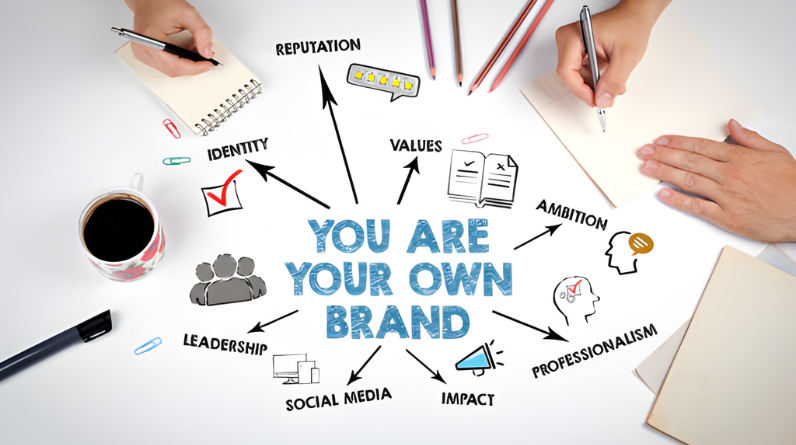In the entrepreneurial world, your personal brand isn’t just a nice-to-have accessory—it’s your operating system. Just as your computer can’t function without an OS, your entrepreneurial journey struggles without a well-defined personal brand powering every interaction, decision, and opportunity.
According to LinkedIn research, 92% of buyers are more likely to engage with business leaders recognized as thought leaders in their field. Meanwhile, 74% of American consumers trust someone with a respected personal brand. These aren’t just vanity metrics—they represent the tangible business impact of strategic personal branding.
This guide explores personal branding through a fresh lens: treating it as the foundational infrastructure that powers your entrepreneurial success, rather than just another marketing tactic.
Why Personal Branding is Your Entrepreneurial Operating System
Think of your personal brand as the invisible architecture that supports everything you build. Just as an operating system manages resources, facilitates processes, and creates a consistent user experience, your personal brand orchestrates how the world interacts with your entrepreneurial ventures.
Unlike traditional marketing that focuses on products or services, personal branding centers on you—the entrepreneur—as the core differentiator. When Jeff Bezos steps down from Amazon, the company continues. But when Elon Musk tweets, Tesla’s stock moves. That’s the power of a personal brand operating system at work.
The Personal Brand vs. Corporate Brand Matrix
| Aspect | Personal Brand | Corporate Brand |
|---|---|---|
| Core Focus | Individual identity and values | Company reputation and products |
| Flexibility | High—pivots with entrepreneur | Low—tied to business model |
| Trust Factor | Built on authenticity and relatability | Built on consistency and quality |
| Longevity | Transcends individual ventures | Tied to company existence |
| Connection Type | Emotional and personal | Transactional and functional |
The Three Pillars of Your Personal Brand Architecture
Every powerful personal brand rests on three interconnected pillars. Understanding and optimizing each creates a stable foundation for long-term entrepreneurial success.
Pillar 1: Identity Core
Your identity core encompasses your values, expertise, and unique perspective. This isn’t about creating a persona—it’s about excavating and articulating who you authentically are. Gary Vaynerchuk’s relentless energy and hustle mentality isn’t manufactured; it’s his genuine operating mode amplified for clarity.
Key components include:
- Core values that guide decision-making
- Specialized expertise and knowledge domains
- Personal experiences that shape your worldview
- The unique intersection of your skills and passions
Pillar 2: Messaging System
Your messaging system is how you translate your identity core into communications that resonate with your target audience. Oprah Winfrey mastered this by consistently delivering messages of empowerment, authenticity, and personal growth across every platform.
Effective messaging requires:
- A clear unique value proposition (UVP) that differentiates you
- Consistent tone of voice across all channels
- Strategic storytelling that creates emotional connections
- Content themes that reinforce your expertise
Pillar 3: Visual Identity
Visual identity extends beyond logos and color schemes to encompass how you present yourself across physical and digital spaces. From your professional attire to your website design, visual consistency builds recognition and reinforces credibility.
Visual elements to consider:
- Professional photography that captures your personality
- Website design that reflects your brand values
- Social media aesthetics and content formatting
- Personal style choices that align with your industry positioning
Building Your Personal Brand: The 7-Phase Framework
Creating a powerful personal brand isn’t about overnight transformation—it’s a systematic process that compounds over time. Here’s a strategic framework for building yours.
Phase 1: Self-Audit and Discovery
Begin by conducting a comprehensive self-assessment. What are your non-negotiable values? What unique experiences have shaped your entrepreneurial perspective? Where do your skills, passions, and market needs intersect?
Action steps:
- List your top 5 professional strengths and supporting evidence
- Identify 3-5 core values that guide your decisions
- Document your entrepreneurial journey, including failures and lessons
- Survey 10 people who know you professionally about how they’d describe you
Phase 2: Define Your Unique Positioning
Your unique selling proposition (USP) is the foundation of your personal brand. It answers: “Why should someone pay attention to you instead of countless other entrepreneurs?”
Consider how you complete this sentence: “I help [target audience] achieve [specific outcome] through [unique approach].”
Phase 3: Build Your Digital Headquarters
Your personal website serves as the central hub of your brand—the place you control completely. Unlike social platforms that change algorithms and rules, your website is your permanent home on the internet.
Essential website elements:
- Clear value proposition above the fold
- Compelling origin story that builds connection
- Portfolio or case studies demonstrating expertise
- Regular blog or content section for thought leadership
- Easy contact and engagement options
Phase 4: Create Your Content Ecosystem
Strategic content creation positions you as a thought leader while providing value to your audience. The key is consistency and quality over volume.
Platform selection guide:
- LinkedIn: B2B entrepreneurs, thought leadership, professional networking
- Twitter/X: Real-time engagement, industry commentary, personal insights
- Instagram: Visual storytelling, behind-the-scenes, lifestyle entrepreneurs
- YouTube: Long-form education, tutorials, in-depth expertise sharing
- Medium: Long-form thought leadership, deep-dive articles
Phase 5: Master Strategic Storytelling
Facts inform, but stories transform. Your entrepreneurial journey—complete with struggles, setbacks, and victories—creates the emotional resonance that turns followers into advocates.
Effective brand storytelling includes three elements: challenge, transformation, and lesson. Share not just what happened, but what you learned and how it shaped your approach to business.
Phase 6: Build Purposeful Relationships
Personal branding isn’t a broadcast medium—it’s a relationship-building tool. Strategic networking amplifies your reach and creates opportunities that pure content creation cannot.
Networking strategies:
- Attend industry conferences and actively participate in discussions
- Join entrepreneurial communities and provide value before asking for anything
- Seek strategic collaborations with complementary personal brands
- Engage meaningfully with influencers’ content in your industry
- Host or participate in podcasts, webinars, and virtual events
Phase 7: Measure, Optimize, and Evolve
What gets measured gets managed. Track both quantitative metrics (followers, engagement, website traffic) and qualitative feedback (testimonials, opportunities, relationship quality).
Key performance indicators:
- Social media engagement rates and follower growth
- Website traffic and time-on-site metrics
- Speaking invitation and media feature frequency
- Partnership and collaboration opportunities
- Revenue attributed to personal brand visibility
The ROI of Personal Branding: Measuring What Matters
Personal branding skeptics often question the return on investment. However, the benefits extend far beyond vanity metrics, creating tangible business value.
Direct Business Impact
| Benefit Category | Measurable Outcomes |
|---|---|
| Lead Generation | Inbound inquiries, partnership requests, investor interest |
| Authority Building | Speaking invitations, media features, expert positioning |
| Network Quality | Access to industry leaders, mentors, strategic partners |
| Risk Mitigation | Ability to pivot ventures while maintaining audience trust |
| Premium Positioning | Higher pricing power, selective client/project choice |
Common System Failures and Debugging Strategies
Even well-intentioned entrepreneurs encounter personal branding challenges. Understanding common failure points helps you avoid costly mistakes.
Failure 1: The Authenticity Gap
Problem: Creating a persona that doesn’t align with your true self leads to burnout and audience disconnect.
Solution: Embrace vulnerability and share both successes and struggles. Authenticity builds deeper connections than perfection ever could. When you share your failures alongside your wins, you humanize your brand and create relatability.
Failure 2: Inconsistency Syndrome
Problem: Sporadic posting, conflicting messages, or visual inconsistency confuses your audience and dilutes brand recognition.
Solution: Develop a content calendar and brand style guide. Consistency doesn’t mean posting daily—it means maintaining a reliable presence and coherent message across all touchpoints.
Failure 3: The Echo Chamber Effect
Problem: Only engaging with people who agree with you limits growth and creates blind spots.
Solution: Actively seek diverse perspectives and engage in respectful dialogue with different viewpoints. This strengthens your critical thinking and expands your appeal beyond a narrow audience segment.
Failure 4: Neglecting the Feedback Loop
Problem: Building a brand in isolation without audience input leads to misalignment with market needs.
Solution: Regularly survey your audience, monitor analytics, and adjust your approach based on what resonates. Your personal brand should evolve with your audience’s needs and your own growth.
Future-Proofing Your Personal Brand in the AI Era

As artificial intelligence reshapes content creation and digital marketing, authentic personal branding becomes more valuable, not less. AI can generate content, but it cannot replicate genuine human experience, emotional intelligence, and authentic relationship building.
Strategies for AI-age personal branding:
- Double down on authentic storytelling that AI cannot replicate
- Leverage AI tools for efficiency while maintaining your unique voice
- Focus on deep, meaningful engagement over surface-level interactions
- Build community and foster real relationships, not just follower counts
- Emphasize experiences and insights that only come from lived entrepreneurial journey
Taking Action: Your 30-Day Personal Brand Launch
Theory without action creates zero results. Here’s a practical 30-day roadmap to jumpstart your personal branding journey:
Week 1: Foundation
- Complete self-audit and define core values
- Craft your unique value proposition
- Audit current online presence and identify gaps
Week 2: Infrastructure
- Set up or refresh personal website
- Optimize LinkedIn profile with strategic positioning
- Create content calendar for next 90 days
Week 3: Content Creation
- Publish first thought leadership piece
- Share origin story across platforms
- Engage meaningfully with 20 industry leaders’ content
Week 4: Relationship Building
- Reach out to 10 potential collaborators or mentors
- Join relevant online communities and provide value
- Plan attendance at one networking event or conference
Conclusion: Your Brand, Your Legacy
Personal branding for entrepreneurs isn’t about self-promotion—it’s about strategic self-articulation. It’s the process of clarifying who you are, what you stand for, and the unique value you bring to the entrepreneurial ecosystem.
Your personal brand is the operating system that powers every business relationship, opportunity, and venture you’ll create. Like any operating system, it requires intentional design, regular updates, and continuous optimization. But unlike software that becomes obsolete, a well-built personal brand appreciates in value over time, compounding your credibility, reach, and influence.
The entrepreneurs who thrive in the coming decade won’t just build great products or services—they’ll build personal brands that open doors, create opportunities, and leave lasting legacies that transcend any single business venture.
The question isn’t whether you need a personal brand. You already have one—it’s the impression you leave in every interaction, the perception others hold of you, and the reputation that precedes you. The real question is: will you intentionally design it, or leave it to chance?
Start building your personal brand operating system today. Your future entrepreneurial self will thank you.


